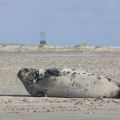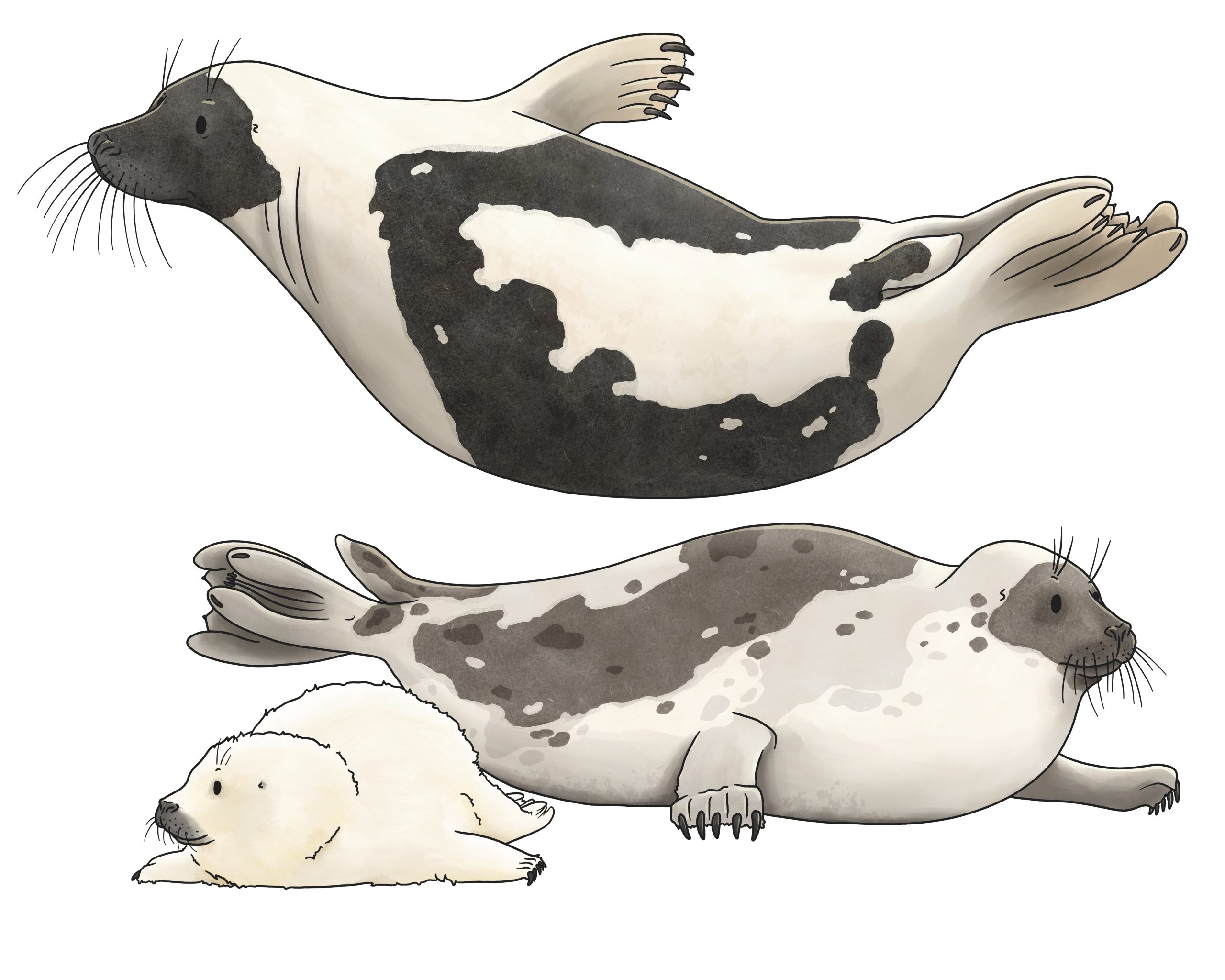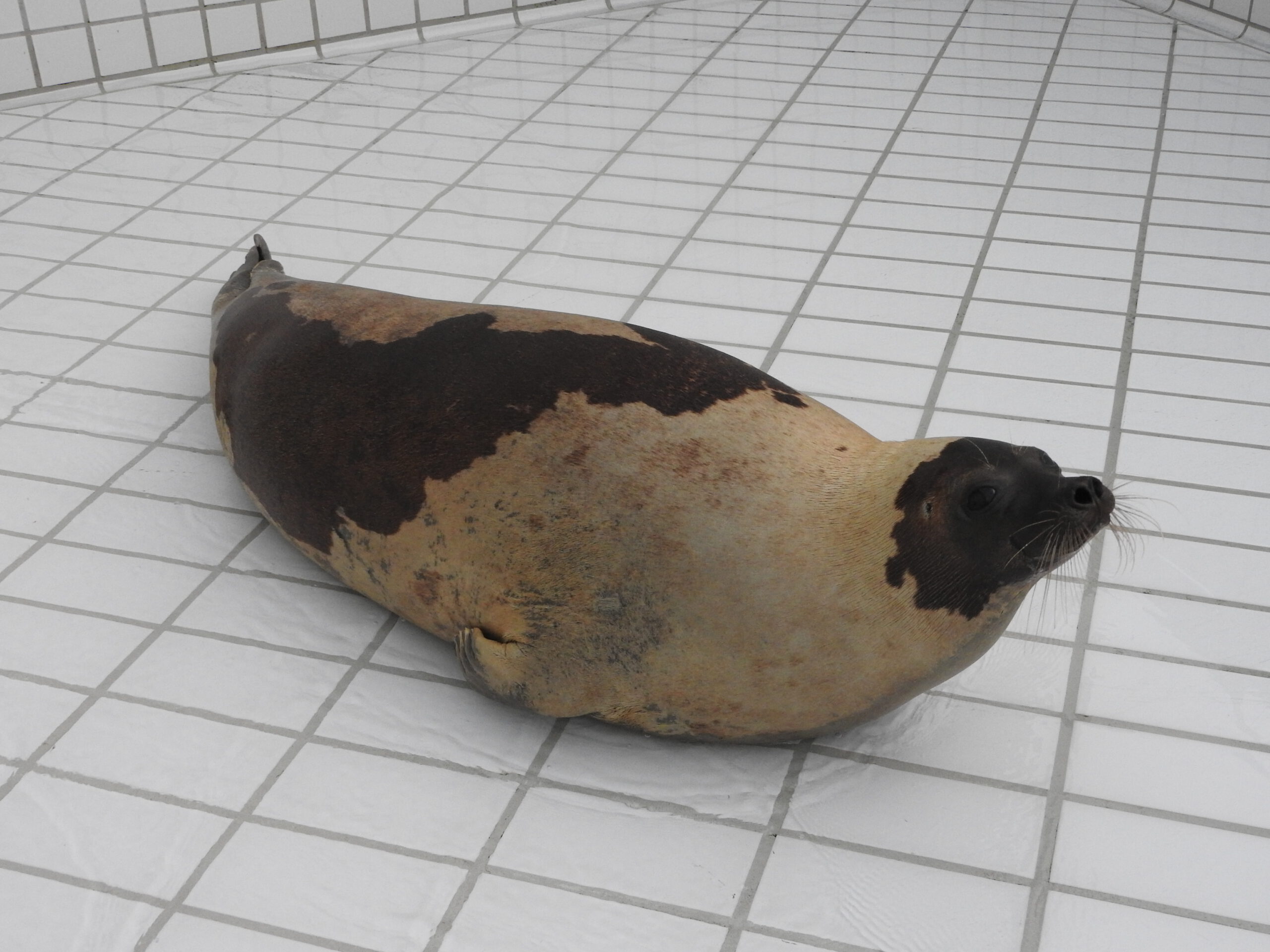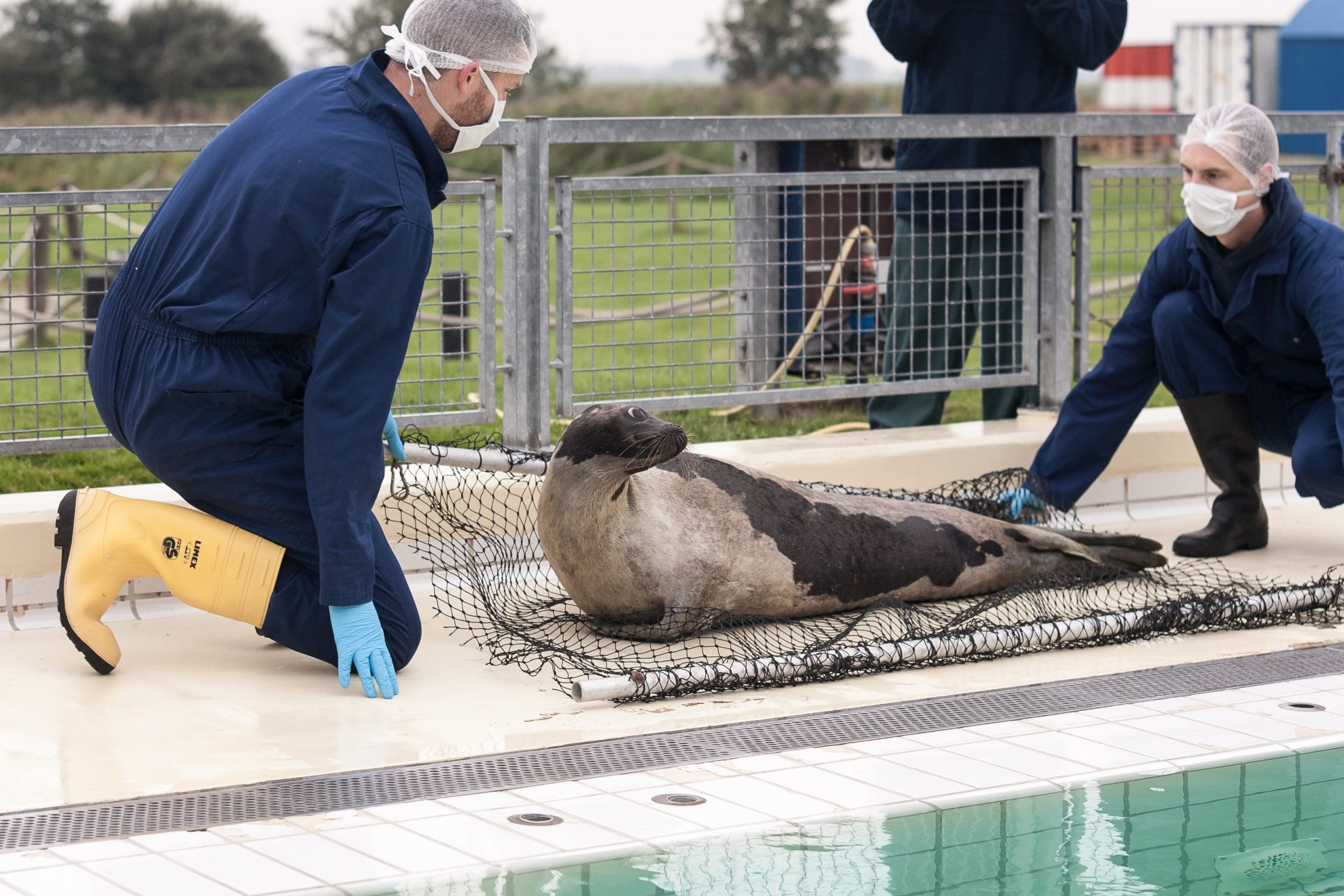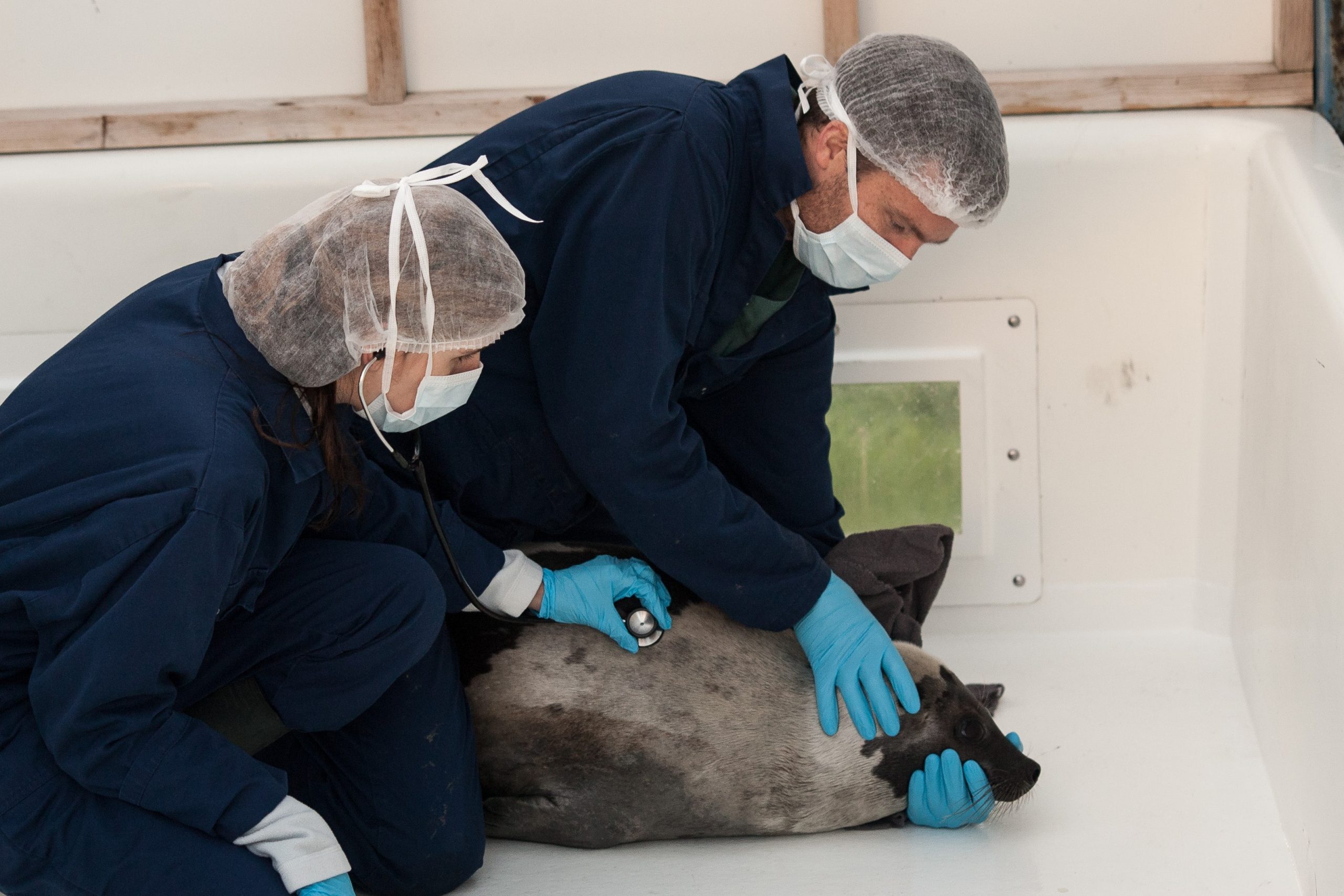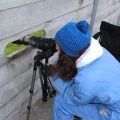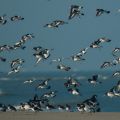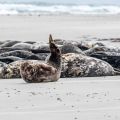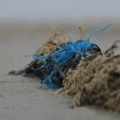Harp seal
Scientific name: Pagophilus groenlandicus
Family: Phocidae
Size: male: 1.90 meter; female: 1.80 meter
Weight: male 140 kilos; female 130 kilos
Habitat: Northwest Atlantic Ocean and the Arctic region
Endangered status: not endangered
See also
"Swallowing stones helps the harp seal with going for a quick deep dive."
External features of the harp seal
The harp seal is a medium-sized seal species. Their body shape is somewhat elongated. The species has a pointed snout with eyes that are close together. But the most recognizable thing about the species is the saddle-shaped marking on their back. The species is therefore also called saddleback seal. In addition to the dark marking on the back, the harp seal also has a dark head.
Gender differences
Males are slightly larger than the females and have a more distinct color difference in their fur. In males, the saddle-shaped marking is dark and very noticeable, because the rest of the body is white. In females, the color sometimes differs from dark to gray and from white to light gray. Furthermore, there is little difference in appearance between males and females.
Distribution and status
Although they all belong to the same species, scientists distinguish three different populations of harp seals in the North Atlantic and the Arctic Ocean. The difference between these populations is mainly in the location where they birth their pups. The three populations are those of the Northwest Atlantic, the Northeast Atlantic and the Barents Sea.
The Northwest Atlantic population is further divided into two major groups: the 'Front' herd which births their pups off northern Newfoundland and southern Labrador, and the 'Gulf' herd that gives birth in the southern Gulf of St. Lawrence.
With over 7 million animals wordwide, the harp seal is not considered endangered. In fact, populations are growing in certain areas. Traditionally, the harp seal was also found in the Baltic Sea, but they have been eradicated there.
Diet and foraging
Like most seal species, the harp seal is "opportunistic". That means they eat whatever food is best to grab at the time. They don't make a big deal about it.
Did you know...
Harp seals in migration can cover as much as 5,000 kilometres a year? That's as far as you would walk from the Netherlands to Egypt.
Harp seals make long migrations during the year. Immediately after mating, harp seals go on a migration, eventually always returning to the mating and suckling grounds.
It is very typical of this species to swim long distances during the year. They follow the edge of the ice and the prey they can find there. So depending on where they are, their main prey also varies. Research has sometimes shown that they eat at least 67 species of fish and 70 species of invertebrates.
The first food for young harp seals are usually swimming crustaceans, such as krill and razor clams. Once the seals are older and can dive deeper, crustaceans, squid and fish are eaten.
Behaviour of the harp seal
Harp seals are very social. They can always be found in small groups on the ice, but also are together in the water. It is not known whether they also hunt in groups.
In the first period after suckling, the pups are alone for a while, but later they join the older animals. At that age, they also have to be very careful not to be caught by polar bears or arctic foxes. Once they become adults, they are no longer bothered by these, but they are still hunted by orcas and large shark species, such as the greenland shark.
Reproduction in harp seals
Mating behaviour
When the female finishes suckling the pup, she can mate immediately. The males know this. Hence, they fight with other males on the ice during this period for the females. Eventually, she mates in the water with the male of her choice. Immediately after mating, migration starts.
Diapause and pregnancy
The fertilised egg is not transferred to the uterus until three to four months after fertilisation. This is called diapause. After that, a harp seal female is pregnant for eight months.
Pups
When harp seals are born, they weigh an average of 11 kilos and are about 75 centimetres long. Newborn harp seals have a white coat (the lanugo coat), which keeps them warm on the ice. After the mother finishes suckling, the white fur falls out and they develop a silvery fur with a few dark spots. This is called beater-fur.
Did you know...
That when harp seal pups learn to swim, they hit the water with their tails?
The name beater does not refer to the fur, however, but to the fact that at this stage, puppies learn to swim and they hit the water with their tails. They keep this fur for the rest of their first year. After that, the fur becomes more spotted and the seal is called a "bedlam". As the seal ages, it develops more spots, until they reach adulthood. Then the spots disappear. However, some females will keep spots all their lives.
Birth and nursing period
Harp seals take advantage of the brief moment in the year when there is a thick layer of pack ice. On this layer of ice they have the "land" they need to have their young.
The suckling period lasts about 10 to 12 days. During this time, the pup gains more than 20 kilos. Then the mother leaves the pup and it is left alone on the ice. Here the process of moutling to the beaterfur begins. They may be left like this for up to 6 weeks without food. In these extreme cases, they lose half their body weight again. Eventually, hunger causes them to search for food in the cold arctic waters.
Harp seal in Sealcentre Pieterburen
In October 2016, we caught a harp seal. Very exceptional, because normally this seal species is are not found in the Netherlands. She was found severely weakened near Den Oever. She weighed only 60 kilos, while an adult harp seal should weigh between 140-150 kilos. Fortunately, she was eventually able to recover and be released. And that was quite a special moment. Read the story of Summer the harp seal here.
